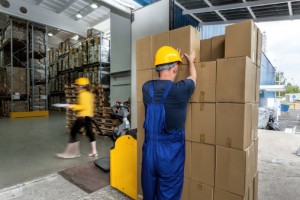Dealing with Difficult-to-Lift Objects — Safely
 Back injuries can be a pain — literally! Unfortunately, they are one of the most common injuries that happen in the workplace. The Bureau of Labor statistics says that more than one million U.S. workers suffer from back injuries every year. They also report that three out of four back injuries are caused by improper lifting. Proper lifting technique can minimize these risks at the workplace and in your daily life.
Back injuries can be a pain — literally! Unfortunately, they are one of the most common injuries that happen in the workplace. The Bureau of Labor statistics says that more than one million U.S. workers suffer from back injuries every year. They also report that three out of four back injuries are caused by improper lifting. Proper lifting technique can minimize these risks at the workplace and in your daily life.
The safest way to lift
You should always lift within your “power zone,” a term that refers to the ideal level at which you hold or carry a heavy object while lifting. The power zone is located in the area above the top of your knees and below the neck. That is where carried items should be lifted to.
In a perfect world, this would be easy — but what do you do when confronted with an object or condition that makes proper lifting technique difficult?
Check out these problems and their solutions so you can lift safely no matter the circumstance.
Problem: The item is too heavy to comfortably carry alone.
Solution: Loads heavier than 50 pounds can be dangerous for single person to lift. Use a fork lift or other material handling equipment to assist you, or lift with the assistance of another person. If possible, break the load into smaller quantities to transport.
Problem: The position from which I’m lifting is awkward.
Solution: Twisting or bending the spine while lifting can increase strain on the lower back and lead to painful injuries. Instead, shift items on floor closer to the body before lifting. Keep heavy objects off floor, if possible, and use ladders or aerial lifts for lifting items to or from high places.
Problem: I’m carrying items for extended periods of time/long distances.
Solution: Extended lifting can increase risk of shoulder and back injury and quickly fatigues muscles. Instead, use stands, jigs, or mechanical lifting devices to hold heavy objects; working in teams with one holding and one assembling or spotting. Rotate these duties often to allow rest.
Problem: The item I’m carrying has no adequate handholds.
Solution: Without proper handholds, you risk dropping the item on yourself. Use the appropriate slots or holes if present, or move the object into a container with proper handholds. Wear personal protective equipment (PPE) such as gloves and protective boots to increase grip and minimize risk.
Regardless of the situation, always use best practices when lifting objects. Your safety comes first, and you should always be minimizing risk for yourself.
Keep yourself safe at work by following these tips and techniques for proper lifting practices.

